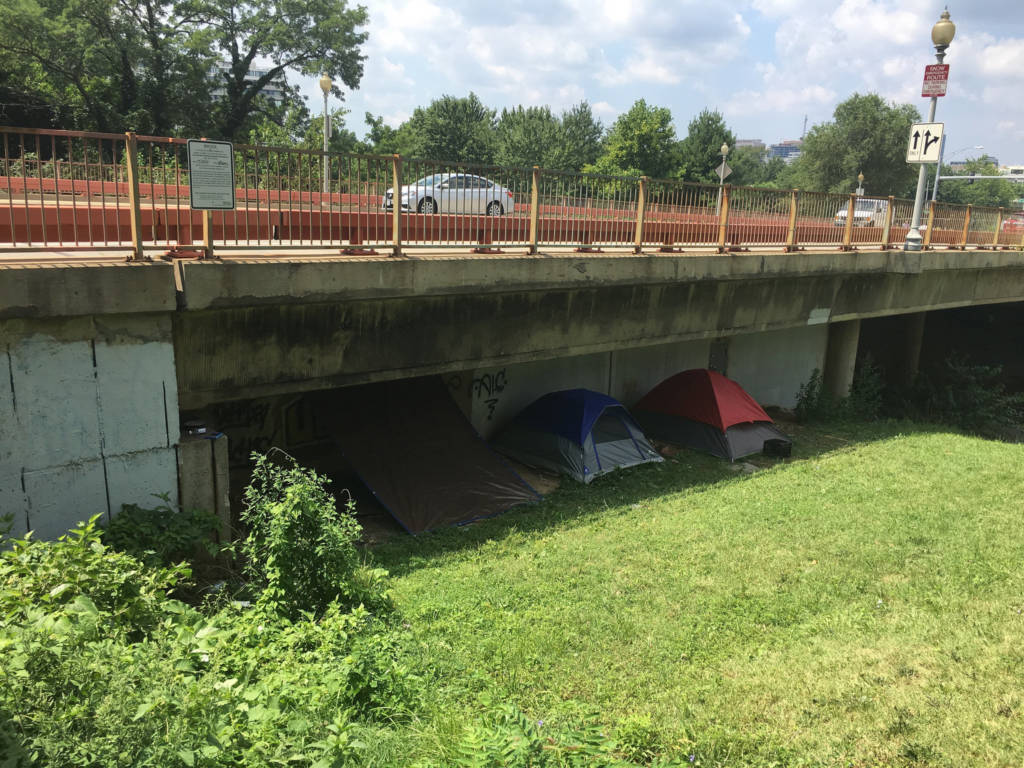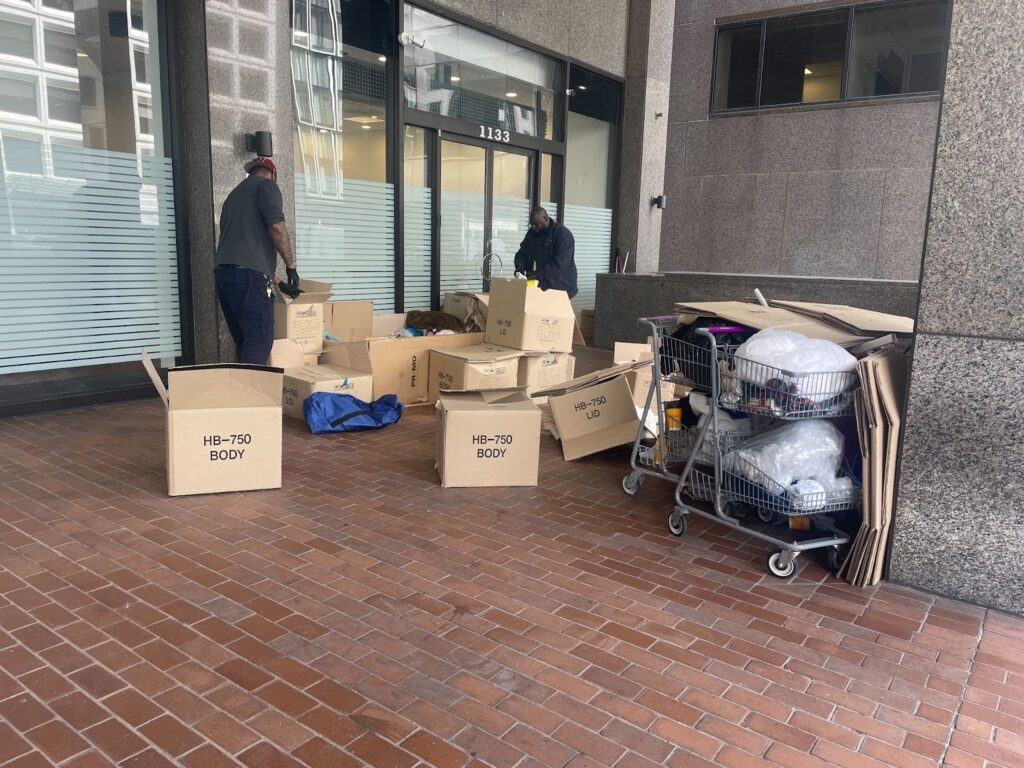At 10:40 a.m., the temperature had already broken into the 80s and was shooting toward mid-90s as M. Leigh and her partner, Donnell, sat on crates in the shade of the K Street bridge, near 26th Street and Whitehurst Freeway. Beside them lay two squares of canvas — flattened tents that were usually propped up during the day.
Above them, the railing that lined the walkway had been affixed with a metal advisory that D.C. government would conduct a cleanup of the area “on or after” July 22 at 10 a.m. According to the sign, M. Leigh and Donnell had overstayed their welcome by 40 minutes.
The notice will expire two weeks after the posted date, which is August 5. At that point the city would have to give two additional weeks of notice before conducting a cleanup, according to Rachel Joseph, Chief of Staff for the Office of the Deputy Mayor for Health and Human Services (DMHHS).
Seen up close, there is a line around the dates on the advisory sign, the edge of the tape used to cover up the dates from the last cleanup in the area. The lawn and neighboring spaces — next to the Watergate complex and surrounded by busy streets and overpasses — have become an often used and clearly visible encampment site ever since tent donations to people living outdoors increased last fall.
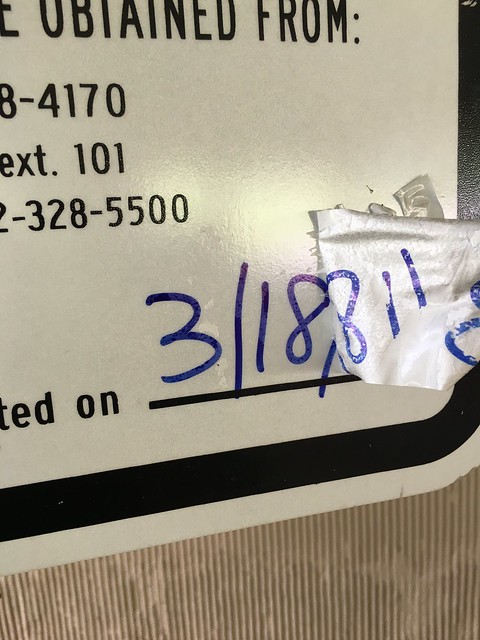
Mayor Muriel Bowser made a statement last November regarding the site, in which she said capacity remained in the D.C. shelters. But with beds reportedly available to the homeless, and guaranteed during the November-March hypothermia season, the question of why some people still elect to stay outside remains.
“That is the million-dollar question,” said Caitlin DiMaina, a case manager at Pathways to Housing who has done outreach ahead of other encampment cleanups. “One answer to it, which turns out to be an obstacle in D.C., is the shelter system.”
Encampment residents gave various reasons for electing to stay outside rather than in a shelter: including theft, distrust of shelter staff and the presence of alcohol and illicit substances.
One such camper, Tony, could not say for certain how long his housing situation had been unstable, bouncing between friends’ couches and the street. However, after staying several nights in D.C. shelters, he no longer considered shelters to be an option.
“Going to sleep at night and waking up with everything that you’d had is very hard in those shelters,” Tony said in an interview. He said he had nine phones stolen while staying in shelters. His collective experiences with petty theft made the issue particularly sensitive.
On a separate occasion outside of a shelter, Tony’s bag — containing all of his identification documents — was stolen. This made already difficult-to-obtain work nearly impossible to find, according to Tony. “All of the things that have been stolen from me, that I have lost in homelessness, are the same things that they require for you to get those things back, so it’s like a trap,” he said. “How do you get out of it?”
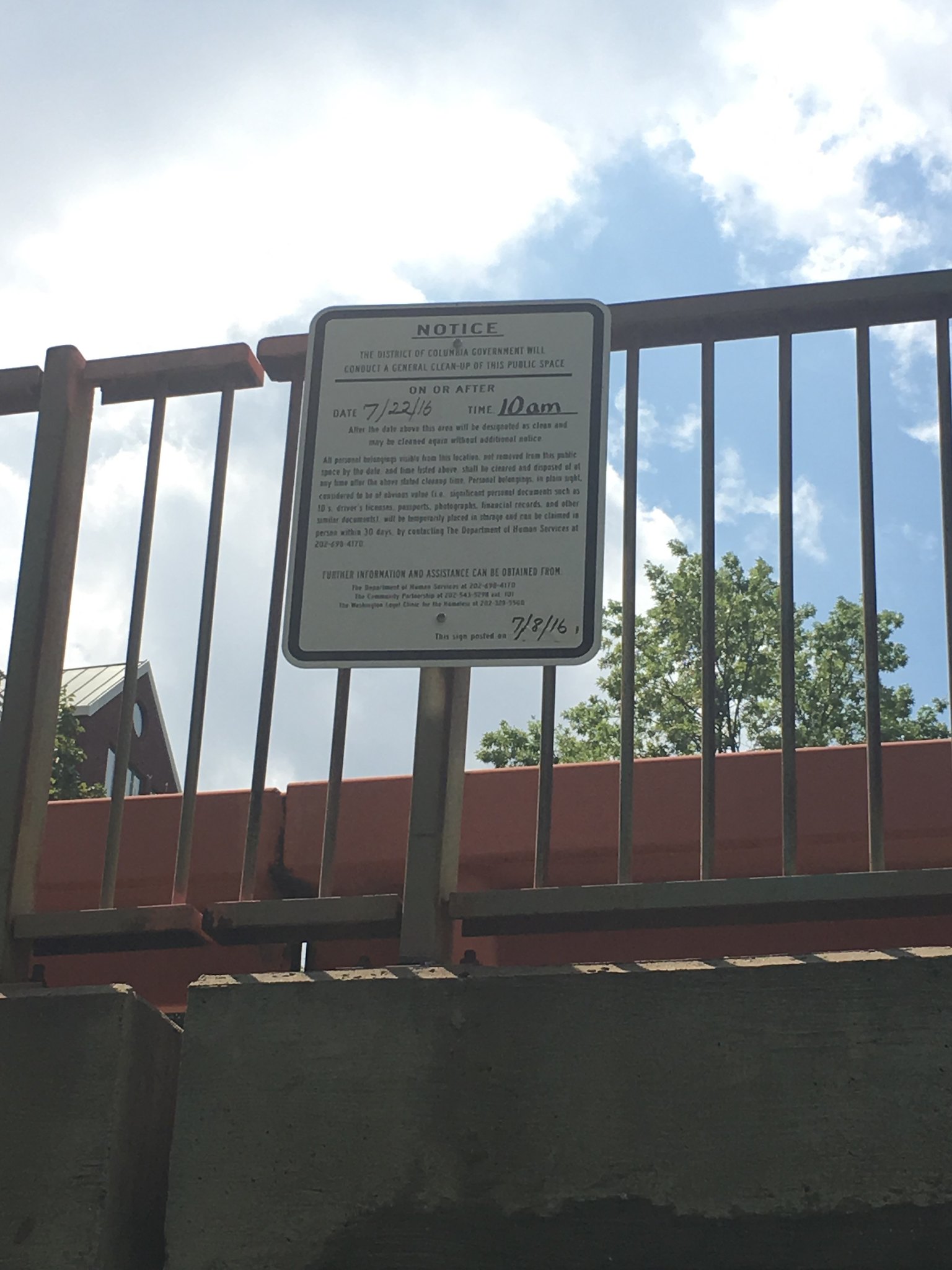
For other campers, mental health is a greater factor in their housing situation. Fidel was one of the homeless campers displaced by a December cleanup of the area which resulted in a field under the Whitehurst Freeway being completely fenced off. It is now used as a staging area for construction work at the Kennedy Center. Fidel has since returned to the area.
Originally from Cuba, Fidel said that his story of homelessness in the U.S. began with his struggle with schizophrenia and alcoholism. He described his mental illness as the battle between himself (Fidel) and Pedro, “The Shadow.” During a cleanup at the Whitehurst site in June, Fidel shook his shoulders to prove he had packed his most important possession: the medication that rattled in his backpack.
While Fidel often visits homeless service providers like Miriam’s Kitchen for meals or case management, he said that sleeping under a roof was worth neither the exposure to alcohol and drugs nor the risk that someone would steal what little he has.
M. Leigh is staying in one of the smaller satellite encampments, across an off-ramp from the central camp. She has stayed in a few D.C. shelters, including the Open Door Shelter for Women, which closed as part of Mayor Muriel Bowser’s effort to improve the shelter system. Residents were moved into the new Patricia Handy Place for Women.
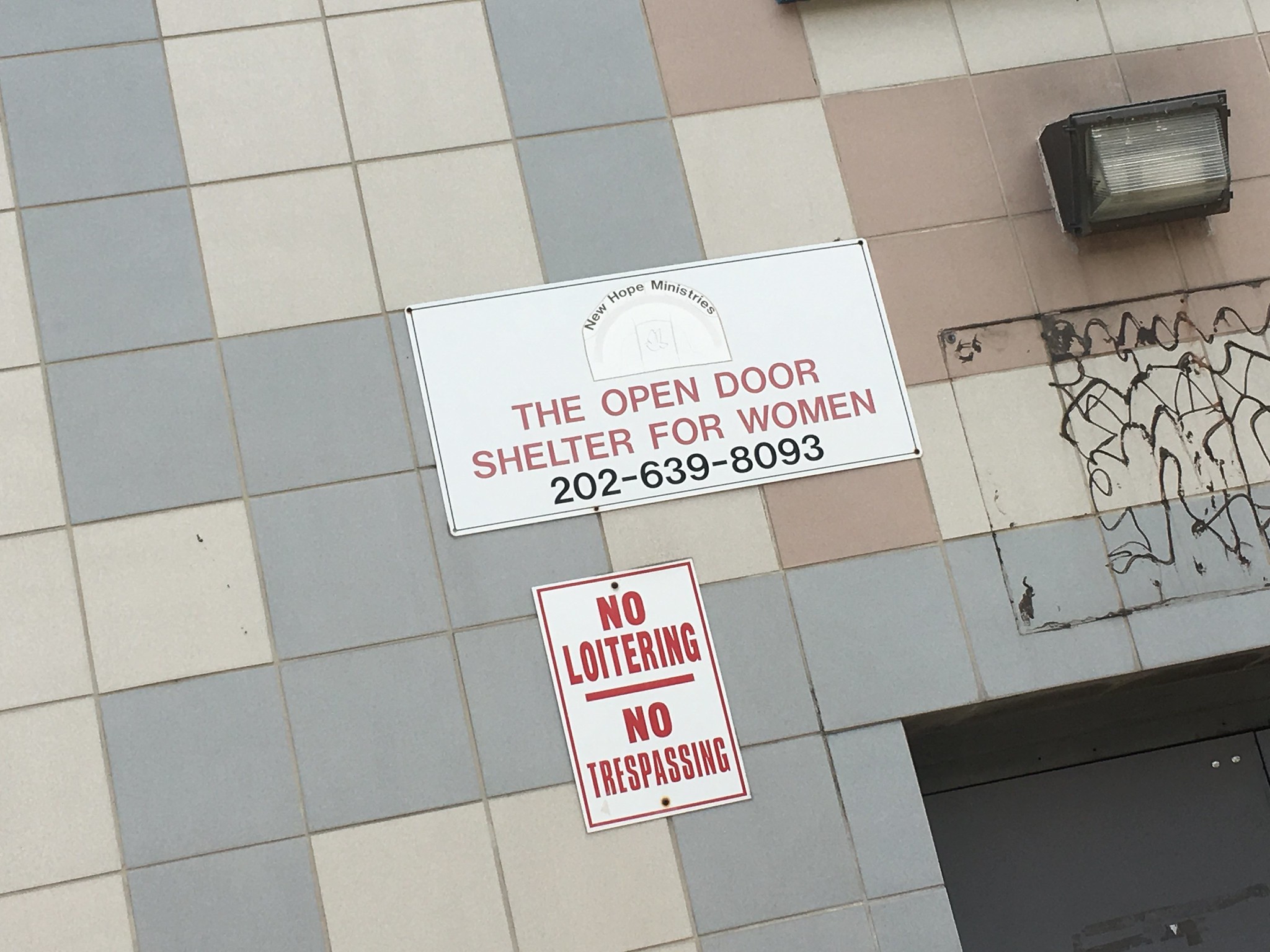
M. Leigh avoids the shelters because she has had negative experiences with shelter staff. “It’s a traumatic event to live in an environment where there’s chaos all the time,” she said. “The [shelter] system is mentally and emotionally abusing the homeless.”
In addition to the campers’ wariness of shelters, the encampments provide the people living there with flexibility. Those with jobs, doctor appointments and visits with case managers may leave the encampments with no concern about returning at a specific hour in order to secure a bed.
Often, members of the encampment can vouch for each other’s belongings, offering both a sense of security and agency over their home. “You can see why choosing to live in encampments would give them more sense of community,” DiMaina said.
Although the city has acknowledged problems with D.C. shelter conditions, the people who would benefit directly from shelter improvements must make do while the city works through logistical and political obstacles.
The correct way for homeless people to make do in this interim is an extension of the homelessness debate.
A team at the University of Denver Law School released report in February of the money spent criminalizing homelessness in Colorado, including legislation, enforcement and incarceration. Based on the team’s parameters in the study, D.C. Municipal Regulation 24-121, which prohibits “temporary abodes” and is often cited by law enforcement to displace a homeless camper, would likely qualify as disproportionately affecting — or even targeting — the homeless.
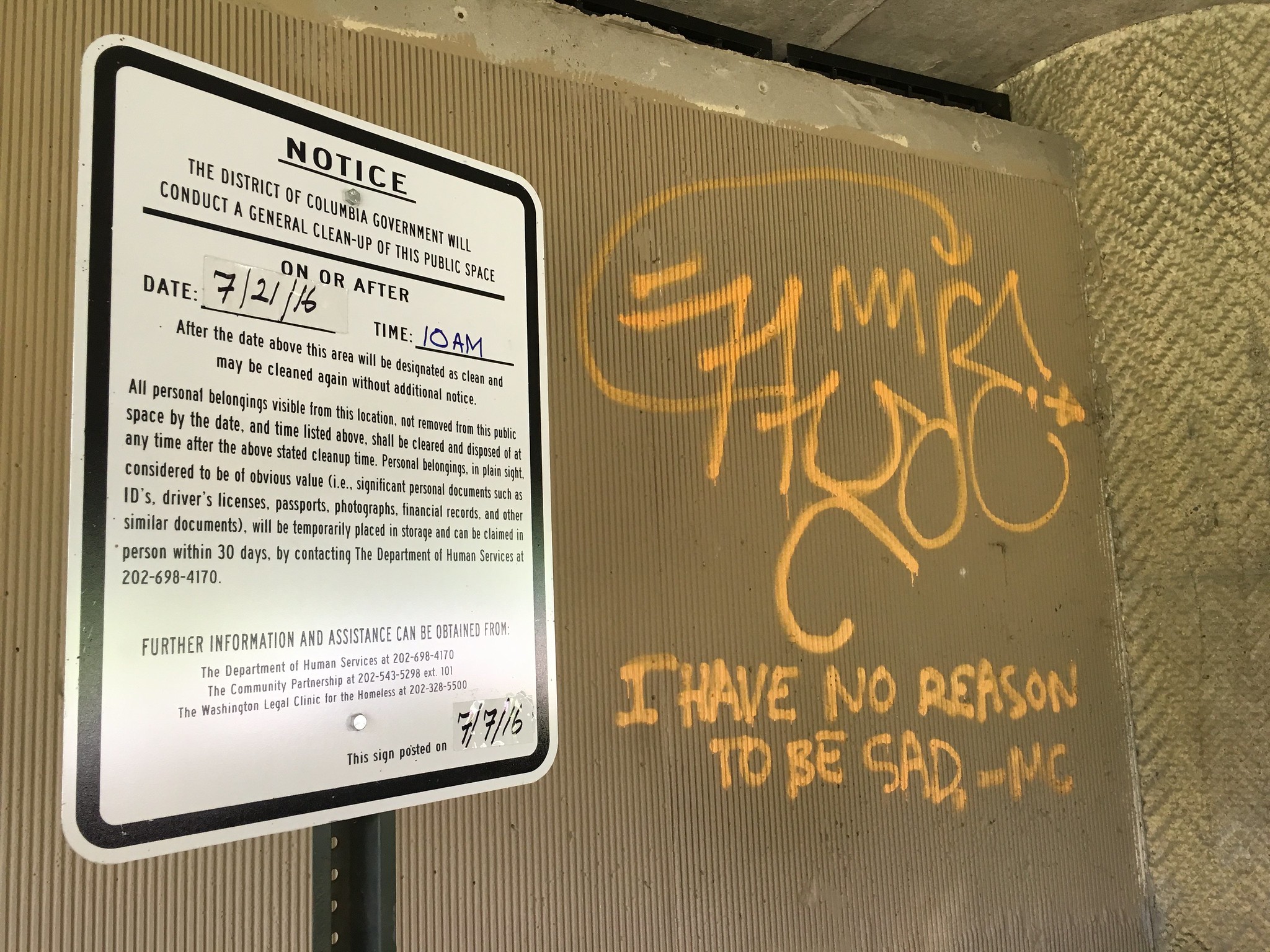
“Ordinances punishing people who are homeless simply because they are homeless will soon become another chapter in a shameful history of laws invalidated for punishing people based on their statuses,” stated the legal team in their report.
D.C. spent more than $170,000 on encampment cleanups between October 2015 and February 2016, according to DMHHS records submitted to D.C. Council.
Two residents of the Whitehurst Freeway site said they understood the encampment was an eyesore for nearby residents who pay high rents. Additionally, sanitation and hygiene are serious and valid concerns for the city as they conduct encampment cleanups, according to DiMaina.
Because the most recent cleanup advisory at the Whitehurst site went into effect last week, the campers keep an extra watchful eye on their belongings and wait for the cleanup crews.
For some, like M. Leigh, the looming cleanup is another emotional torture. For others like Tony, it is another logistic obstacle that just makes the unfathomable predicament of homelessness an impossible one.
“There are people that are homeless that do want to work, that are willing to save their money and work to obtain the things that they have,” Tony said. “I understand that people that have things worked hard and they saved their money to have them, and I agree with that system, but I don’t feel like I’m being given a fair chance to even try to get back on my feet.”
